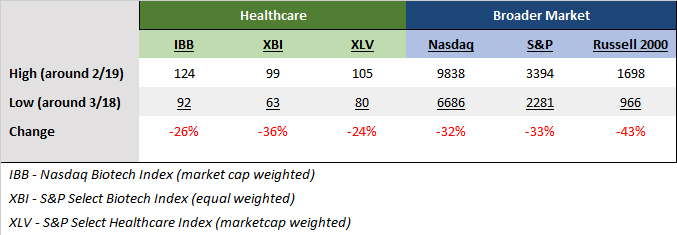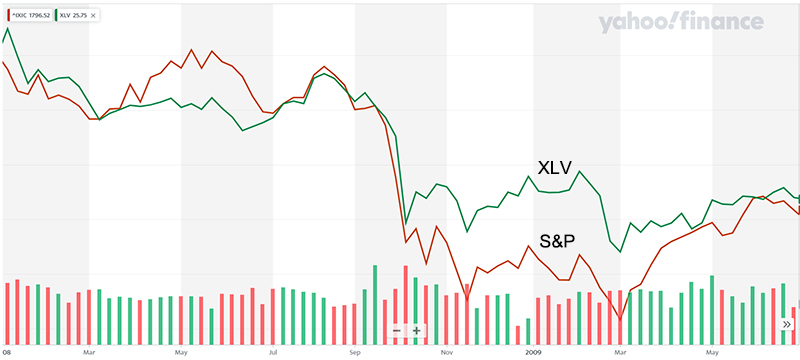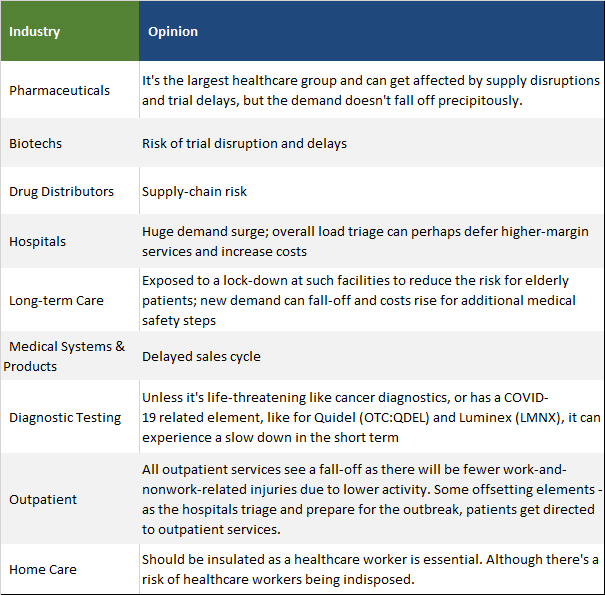Biotech Pulse
With the first half of 2021 in the history books, it's a good time to review what biotechs accomplished and the outlook for the second half. A detailed annual Biotech Bonanza Outlook was published in January this year. This article is a shorter mid-year update.
It was a difficult first half for biotechs, once again underscoring how conditions may seem so ideal but investment returns can still be hard to generate. The larger-cap leaning Nasdaq Biotechnology Index (IBB) was up +9% for the year (as of July 2), while the smaller and midcap leaning S&P Biotechnology Select Index (XBI) was down -3% for the year. The Prudent Biotech model portfolio was up +46% for the same period, and the broader Prudent Healthcare portfolio was up +57%.
There were pockets of strength in biotechs during the first half, and three of the major highlights were the growing momentum of entrenched COVID-19 vaccine manufacturers, approval of a treatment for Alzheimer's disease, and the unrelenting supply of new biotech stocks.
Vaccines
In the Biotech Bonanza 2021 outlook, we had discussed how the COVID-19 vaccine opportunity doesn’t get any bigger for biotechs, and the opportunity is not going to benefit all, but a select few. Moderna (MRNA), which has been an anchor holding for both the Prudent Biotech and the Prudent Healthcare model portfolios, outperformed in the first half along with fellow mRNA vaccine manufacturer BioNTech (BNTX), who is partnered with Pfizer. As the vaccine opportunity has surged with demand far outstripping global supply, Moderna and Pfizer-BioNTech have become the two most preeminent manufacturers with rapid time-to-market, rapid scaling, and leading product effectiveness. They remain poised as well to be the prime beneficiaries of any booster shot recommendation in the US. In the 2021 outlook, we had noted that all RNA vaccines may not deliver the same results. That was borne out by the study results of CureVac (CVAC), a promising RNA vaccine company from Germany, just like BioNTech, which delivered around 50% efficacy data, thus losing momentum and delivering a blow to global supply. CureVac was using a smaller dose package in its vaccines which may have diminished its effectiveness and its trial population may have comprised more patients affected by the robust coronavirus variants. Novavax (NVAX), which uses its proprietary nanoparticle technology, is a prominent vaccine player with leading trial results but has not yet been able to make a meaningful contribution to vaccine supplies. Perhaps that will change towards the end of the quarter. But its immediate COVID vaccine opportunity now lies primarily outside the US, and maybe if a mix-and-match booster shot is recommended in the US later this year.
FDA’s Approval Boosts Neurodegenerative companies
The FDA's decision in favor of approving Biogen’s (BIIB) drug Aducanumab (marketing name Aduhelm) for Alzheimer’s disease was a pivotal one that shifted the trajectory of the regulatory process for drug approvals. Aducanumab's approval has proved to be highly controversial and already is encountering payor pushback. But the FDA’s decision has also created an important precedent, which appears to have de-risked the regulatory pathway for companies pursuing similar treatments. The precedent suggests that a treatment for a high unmet need can be approved on the accelerated pathway with secondary point improvements even if the primary endpoints are not immediately met. The decision sets, what appears to be, a lower bar for approval of such treatments and diminishes regulatory uncertainty. Consequently, it boosted the fortunes of the neurodegenerative companies with promising approaches and encouraging trial results, whose treatments have become highly prized assets. A few big beneficiaries include Prothena (PRTA), Cassava Sciences (SAVA), Anavex (AVXL), Annovis Bio (ANVS), Cortexyme (CRTX), and INmune Bio (INMB).
Biotech IPOs At A Record Pace
Biotech stocks continued to represent the largest proportion of IPOs of any industry group, indicating a highly robust appetite for biotech ideas. New approaches and gene editing continue to find public capital with ease.
However, we believe, the surging supply of new biotech stocks is contributing to an oversupply that is quite likely a meaningful contributor to the industry's weaker performance. The market has been simply awash in biotech shares. This may be true of the broader market as well, with the total year-to-date IPO proceeds last month already passing the entire 2020 pandemic-hit production. Also, a record was set this year for IPO proceeds raised in a six-month period with $350 billion in new equities. The previous record was $282 billion set in the second half of last year. The relatively poor performance of the small and midcap leaning S&P Biotech Index compared to the larger-cap-oriented Nasdaq Biotech Index supports the notion that a deluge of new supply is hurting biotech performance.
Biotech Stocks To Rise In The Second Half
We believe that biotechs as an industry group are best poised for strong performance in the second half. We had discussed some reasons in a recent article, Ready to Roar. Two reasons that provide confidence in a strong second-half performance are interest rates and acquisitions.
Key Interest Rate Falls
The 10-year Treasury yield, a key benchmark, has now retreated to levels last seen in mid-February before the rate rose sharply. Coinciding with the interest rate move higher in February was the peaking of the Nasdaq Biotechnology Index.
Biotechs are driven by scientific advances, good data, and a highly favorable risk-taking environment. Low and steady interest rates are quite instrumental in creating that favorable environment for broader gains.
The biotech stocks emerged from a five-year consolidation with the Nasdaq Biotech Index recording a new high in December 2020, only to end up peaking about two months later, as inflation-driven worries caused the 10-year interest rate to rise sharply. That rate has been drifting lower since June and this month has fallen sharply. Inflation fears will persist for the rest of the year, but the stock market appears to have shifted its focus on the economic outlook for next year with concerns about growth, which will likely keep the 10-year yield within a range. The stabilization of interest rates will provide the favorable backdrop that biotech stocks urgently need.
Typically, multi-year breakouts are powerful and are sustained over the years, interrupted by shorter periods of pullbacks. After a five-month-long consolidation, in our opinion, biotech stocks are positioned to record new highs during the second half as interest rates stabilize.
The new risk from the COVID variant positions biotech stocks much better than most other industry groups which may see some short-term impact, though the economy is unlikely to lose meaningful momentum.
Acquisitions
The biotech industry needs more acquisition activity to drive valuations higher. Such activity has been fairly dormant this year and did not pick up as anticipated. After the Jazz Pharmaceuticals (JAZZ) purchase of GW Therapeutics in February for more than $7 billion, the activity and deal size have dropped precipitously with the largest deal since being the purchase of Five Prime Therapeutics by Amgen (AMGN) for $2 billion in March. This must change.
In the valuation quagmire that biotechs are stuck in with the broader market moving steadily higher, acquisitions will be a key catalyst to expand valuations. Cash is plenty and pharma valuations have climbed this year, while small-and-midcap biotechs have struggled. The S&P biotech index at the beginning of July was down over 20% from its peak in mid-February. Low valuations will attract buyers. As biotech stocks begin to strengthen from the interest-rate-induced decline, it can spur M&A activity.
Upcoming Neurology Conference
The small-and-midcap neurology group has witnessed strong interest and momentum after the approval of Biogen's drug. Companies with investigational treatments for neurological diseases like Alzheimer's and Parkinson's are in the spotlight.
This interest will be further stoked with the upcoming Alzheimer’s Association International Conference (NYSE:AAIC), which will be held in Denver, Colorado, and virtually, from July 26-30. There will be multiple data releases and abstract presentations, including from some of the promising neurology companies that have been mentioned in earlier articles.
One of the most sought-after presentations is expected to be from Cassava Sciences (SAVA). This small-cap company has grabbed the attention this year with its key therapeutic candidate, a compound called Simufilam that's targeted at patients with mild-to-moderate Alzheimer's disease.
Simufilam is an oral, small molecule that binds with high affinity to altered filamin-A (OTC:FLNA), and contributes to restoring its normal shape. FLNA is a scaffolding protein, one that binds two or more proteins to create a functional unit, and is widely found throughout the body. Misfolded or altered FLNA in the brain has been shown in published studies to cause neurological dysfunction, degeneration, and inflammation. Such an altered form of FLNA protein is found in a brain affected by Alzheimer’s disease. By returning the protein to its normal conformation and stabilizing it, Simufilam is being developed to restore the normal functioning of key brain receptors that play pivotal roles in brain cell survival, cognition, and memory, and arrest the toxic effects of the misfolded FLNA. It's important to note that the mechanism of action relies on stabilizing the protein and not removing amyloid from the brain. Simufilam also has a strong anti-inflammatory effect by reducing cytokines in the brain. In our opinion, this is critically important as a combination of restoring key brain receptors along with a powerful anti-inflammatory benefit can be a vitally important differentiator in delivering sustainable positive outcomes.
Earlier in February, the company announced the interim analysis of the open-label study of Simufilam for patients that have been treated for at least 6-months. The treatment improved cognition scores by 1.6 points, a 10% mean improvement from baseline to month 6. The group also showed an improvement in dementia-related behavior, by 1.3 points, a 29% mean improvement from baseline to month 6. Notably, the compound was able to not only arrest cognitive decline but even improve it.
On Monday, July 26, the company will present details on its early detection test, SavaDx, for Alzheimer's disease and how the test has confirmed the mechanism of action of Simufilam. That may provide some early clues on the data to be released later next week.
On July 29, at the conference, Cassava Sciences will be releasing an interim analysis for the first 50 patients to complete the nine months of open-label treatment. It should be noted that no drug has shown a positive outcome at the nine-month mark. Even Biogen's Aduhelm and Eli Lilly's (NYSE:LLY) Donanemab, which intends to approach FDA now for accelerated approval, have shown cognitive declines at the nine-month treatment point. Even though Simufilam's data is from an open-label study, and not a blinded one, its importance still cannot be discounted as a stable reading that matches the six-month interim analysis will be an industry first. If there is a cognitive improvement at the nine-month level, it will be truly historic. We believe with the additional benefit of an anti-inflammatory characteristic of the compound, anything is possible, including a cognitive improvement. If there's a decline in cognitive and behavioral metrics at the nine-month point, it will be considered a near-term disappointment even though the drug will still remain on track for approval based on future Phase 3 studies.
Save Therapeutics was covered in more detail in an earlier article, 3 Neurology Stocks.
At the same AAIC event, Annovis Bio (ANVS) will release its abstract and poster presentation on the positive outcomes from its two Phase 2a studies in Alzheimer's and Parkinson's. Earlier in May 2021, Annovis Bio released some compelling data on its lead drug, ANVS 401, which showed material cognitive improvement in Alzheimer's and Parkinson's patients.
As a result of the Aducanumab precedent set by the FDA, the Alzheimer's conference has acquired significantly more importance and interest this year, and it will not disappoint in providing market-moving news.
Conclusion
Biotech stocks have been lagging the market. However, conditions are improving and a biotech exposure can be rewarding as a combination of stabilizing interest rates, the potential ramp-up in acquisition activity, and positive data readouts, deliver a powerful second-half performance. Portfolio exposure to biotech stocks, we believe, will be quite rewarding. In our 2021 outlook in January, we anticipated the Nasdaq Biotechnology Index to record a 20% return in 2021. We believe the return expectation is quite achievable and will require more than a tripling of the present performance of about 6% return.
Some promising companies, which now or in the past may be part of the Prudent Biotech or Prudent Healthcare model portfolio, include Moderna (MRNA), BioNTech (BNTX), Beam Therapeutics (BEAM), Cassava Sciences (SAVA), Anavex Life Sciences (AVXL), Prothena (PRTA), Annovis Bio (ANVS), Celldex Therapeutics (CLDX), Denali Therapeutics (DNLI), Intellia Therapeutics (NTLA), Beam Therapeutics (BEAM), Arvinas (ARVN), INmune Bio (INMB), Biohaven Pharmaceutical (BHVN), Translate Bio (TBIO), Agenus (AGEN), Intra-Cellular Therapies (ITCI), Cortexyme (CRTX), Karuna Therapeutics (KRTX), Protagonist Therapeutics (PTGX), and CorVel Therapeutics (CRVL).
Biotech stock investing is volatile and high risk. Investors should pursue a concrete investment strategy preferring a portfolio approach by investing in a basket of promising companies that can assist in managing risk and overcoming mistakes.
This article was first published on Seeking Alpha.



